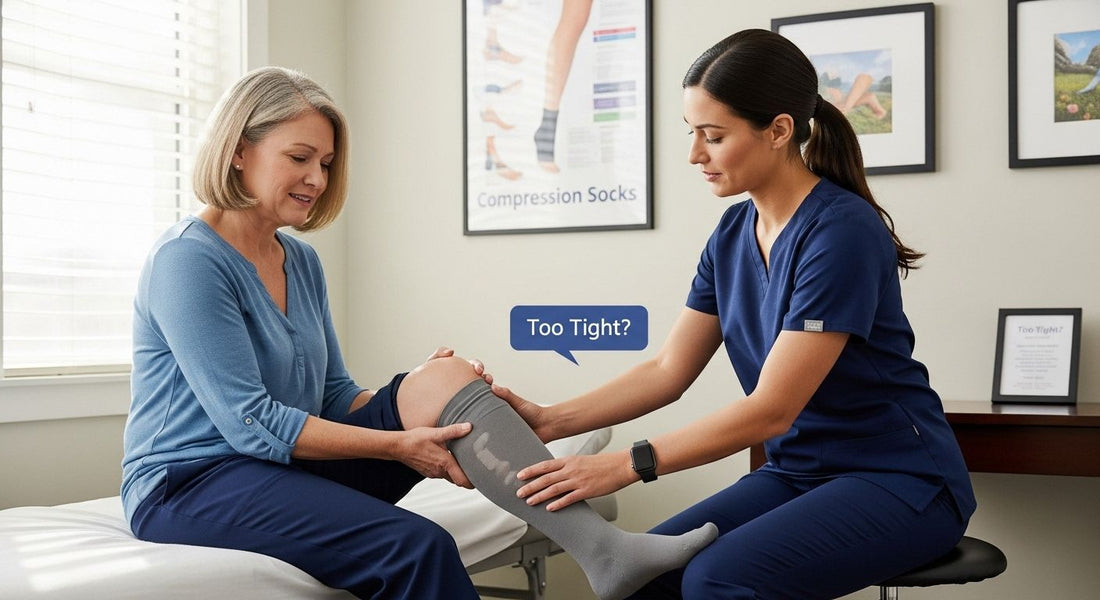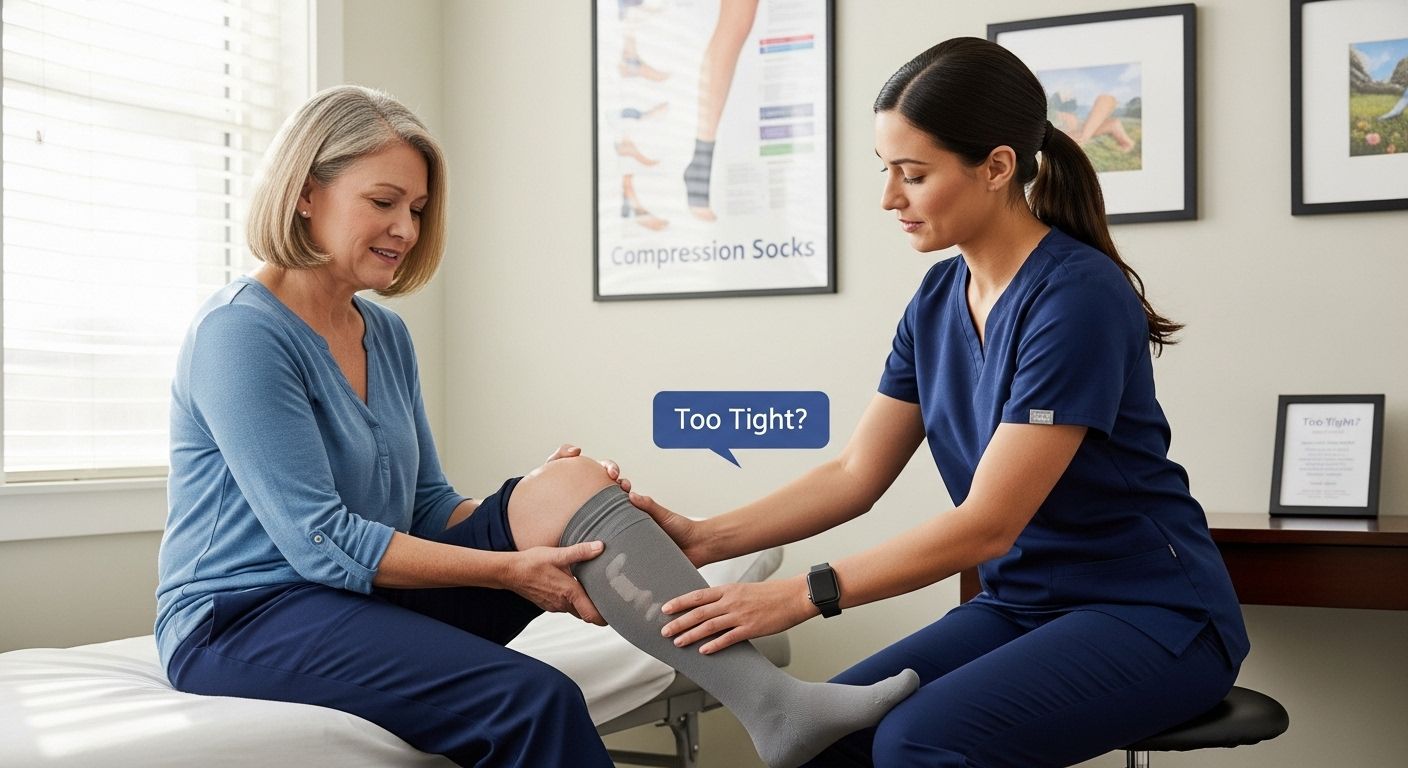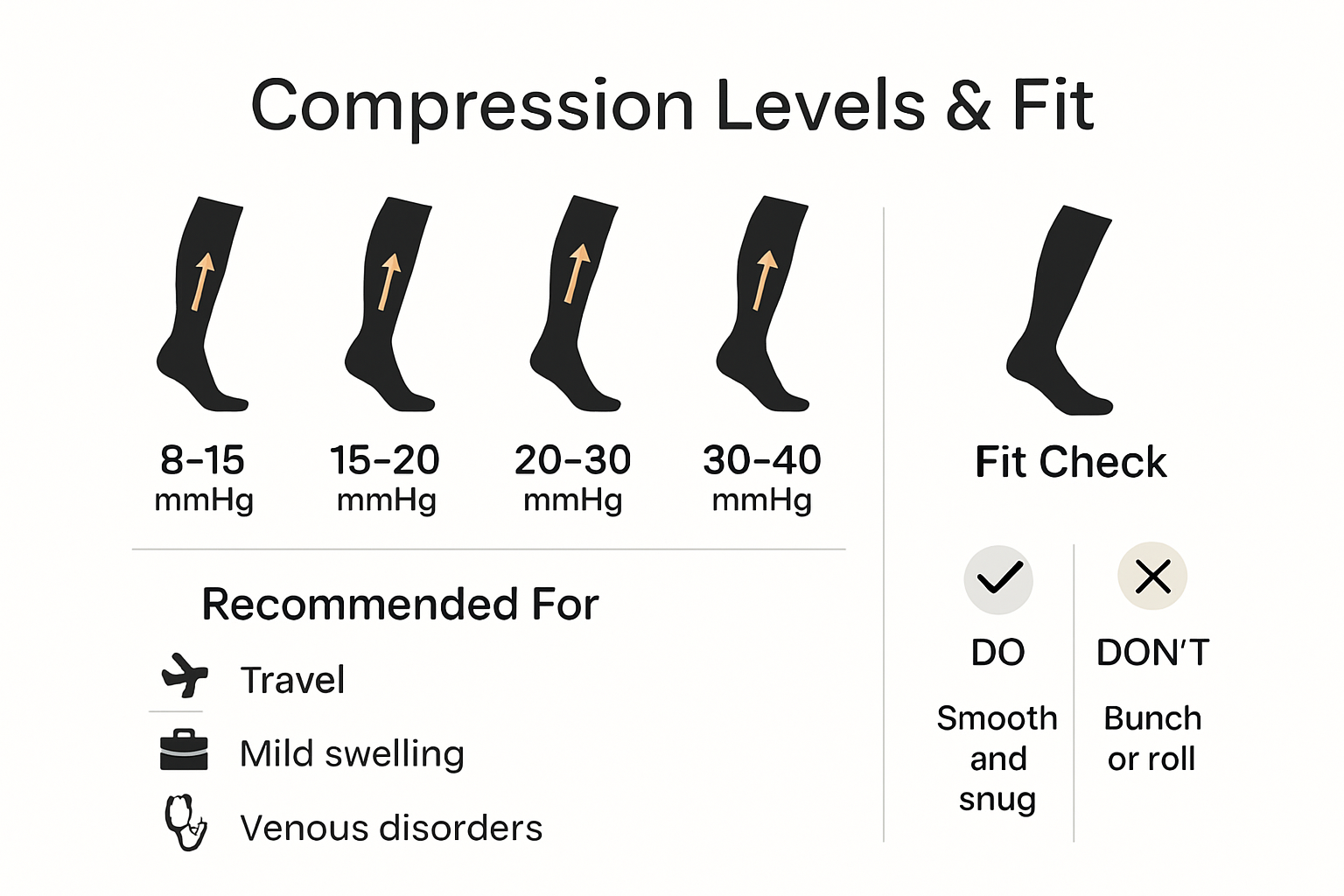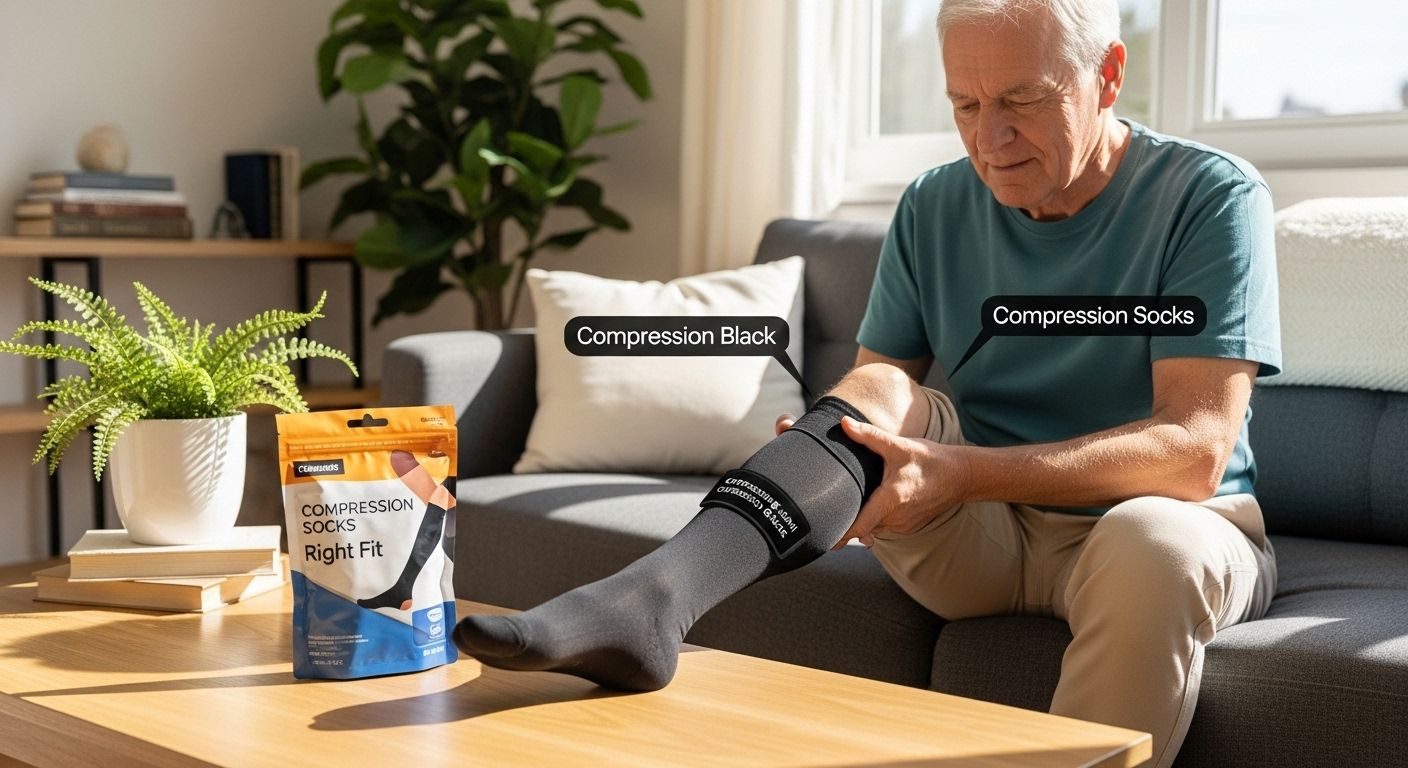
Can Compression Socks Be Too Tight? What You Need to Know 2025
Share

Compression socks promise relief for tired legs and healthier veins. Experts say they help boost blood flow and can even lower your risk of dangerous clots for millions of athletes, patients, and travelers every year. Most people focus on buying the strongest pair they can find. Surprisingly, tighter is not always better and socks that squeeze too much might actually put your health at risk.
Table of Contents
- How Compression Socks Work And Who Benefits
- Signs Your Compression Socks Are Too Tight
- Risks Of Wearing Overly Tight Compression Socks
- Choosing The Right Compression Level And Fit
Quick Summary
| Takeaway | Explanation |
|---|---|
| Compression socks aid circulation and recovery. | They enhance blood flow, reduce swelling, and support leg health for various users, including athletes and medical patients. |
| Identify signs of overly tight socks. | Symptoms like pain, skin irritation, or discoloration indicate improper fit, requiring immediate adjustment or consultation. |
| Risks of tight compression socks are serious. | Excessive constriction may lead to circulatory issues, nerve damage, skin problems, and long-term health complications. |
| Choose the right compression level. | Levels range from mild to extra firm; selecting the correct level ensures therapeutic benefits while preventing discomfort. |
| Proper fitting is crucial for efficacy. | Accurate measurements are necessary to ensure socks fit well and deliver the intended support without causing harm. |
How Compression Socks Work and Who Benefits
Compression socks are specialized medical garments designed to improve circulation and provide therapeutic support for various health conditions. Our comprehensive guide to compression sock benefits offers deeper insights into their medical applications.
The Science Behind Compression Technology
Compression socks work through a precise mechanism of graduated pressure. According to Harvard Medical School, these garments apply strategic pressure that is most intense at the ankle and gradually decreases up the leg. This graduated compression creates a unique physiological response that actively supports blood circulation.
The primary function involves compressing surface blood vessels, which increases blood flow velocity and reduces venous pooling. By applying consistent external pressure, compression socks help blood return more efficiently to the heart, preventing potential complications like deep vein thrombosis and reducing leg swelling.
Who Can Benefit from Compression Socks
Multiple groups of individuals can significantly benefit from compression sock therapy. WebMD research highlights several key demographics that find these garments particularly useful:
-
Athletes and Fitness Enthusiasts: Compression socks help reduce muscle fatigue, improve recovery times, and prevent potential exercise-related leg swelling.
-
Medical Patients: Individuals with circulatory disorders, diabetes, varicose veins, or those recovering from surgery can experience improved blood flow and reduced risk of blood clots.
-
Professionals with Sedentary Jobs: People who sit or stand for extended periods can prevent leg discomfort and reduce the risk of developing circulation-related issues.
-
Pregnant Women: Compression socks can help manage leg swelling and reduce the risk of developing venous problems during pregnancy.
The versatility of compression socks makes them a valuable tool for proactive health management. By understanding their mechanism and potential benefits, individuals can make informed decisions about incorporating these therapeutic garments into their wellness routine. Whether you’re seeking performance enhancement, medical support, or preventive care, compression socks offer a scientifically backed solution for improved leg health and circulation.
Signs Your Compression Socks Are Too Tight
Compression socks are designed to support circulation, but identifying when they become problematic is crucial for maintaining leg health. Learn more about proper compression sock fit to ensure optimal comfort and effectiveness.
Physical Discomfort and Restriction
According to the University of Michigan Health, several key indicators suggest your compression socks might be excessively tight. Persistent pain, intense discomfort, or a feeling of extreme constriction are immediate red flags. When compression socks impede normal blood flow, they transition from therapeutic to potentially harmful.
Signs of overly tight compression include sharp or burning sensations, reduced mobility in the leg, and difficulty putting on or removing the socks. Your socks should feel snug but not painful. If you experience significant resistance when wearing them or feel like circulation is being cut off, this indicates an improper fit.
Skin and Circulation Warning Signs
Below is a checklist table highlighting the key warning signs that your compression socks might be too tight. Use this as a quick reference to identify potential problems as soon as they occur.
| Warning Sign | Description | Action Needed |
|---|---|---|
| Pain or Discomfort | Persistent pain or extreme tightness | Remove socks, reassess |
| Sharp/Burning Sensation | Unusual sensations, burning, or tingling | Seek medical advice |
| Skin Discoloration | Redness, deep indentations, or bluish skin | Adjust fit, consult MD |
| Numbness or Tingling | Loss of sensation or “pins and needles” feeling | Remove, reassess fit |
| Swelling Below Sock | Swelling in areas below the compressed region | Check blood flow, consult |
| Skin Irritation | Rashes, chafing, or broken skin | Discontinue use, treat |
Research from the National Institutes of Health highlights critical visual and sensory symptoms that signal compression socks are too tight. Watch for these specific indicators:
-
Skin Discoloration: Unusual redness, deep indentations, or bluish skin tones suggest excessive pressure.
-
Numbness or Tingling: Persistent loss of sensation or “pins and needles” feelings indicate potential nerve compression.
-
Swelling Below Compression Area: Unexpected swelling in areas below the sock suggests impaired blood circulation.
-
Skin Irritation: Persistent rashes, chafing, or broken skin can result from socks that are too constrictive.
Professional medical guidance is essential if you experience these symptoms. Compression socks should support circulation, not restrict it. When in doubt, consult a healthcare professional who can assess your specific needs and recommend the appropriate compression level and sizing. Understanding these warning signs helps prevent potential complications and ensures your compression socks provide the intended therapeutic benefits.
Risks of Wearing Overly Tight Compression Socks
Compression socks are designed to support health, but wearing them incorrectly can lead to serious medical complications. Check out our comprehensive guide on proper compression sock care to understand potential risks and prevention strategies.
Circulatory and Neurological Complications
Research from the International Journal of Environmental Research and Public Health reveals that excessively tight compression socks can cause significant physiological disruptions. When compression garments are too constrictive, they can paradoxically impede the very circulation they are intended to improve.
Neurological risks include paresthesia (abnormal sensations like tingling or numbness), nerve compression, and reduced sensation in the legs. These symptoms can be particularly dangerous for individuals with pre-existing medical conditions such as diabetes or peripheral neuropathy, where nerve sensitivity is already compromised.
Skin and Tissue Damage Risks
Overly tight compression socks can create a cascade of dermatological and tissue-related problems. Prolonged excessive pressure can cause:
-
Skin Breakdown: Persistent compression can lead to skin abrasions, cuts, and potential ulceration.
-
Reduced Blood Flow: Extreme constriction might cause localized ischemia, where tissues do not receive adequate blood supply.
-
Pressure Injuries: Deep indentations and continuous pressure can result in permanent tissue damage and scarring.
Long-Term Health Implications
Beyond immediate discomfort, consistently wearing inappropriately tight compression socks can have lasting health consequences. Chronic compression can potentially worsen existing circulatory issues, create new medical complications, and reduce the overall effectiveness of compression therapy.
Professional medical consultation is crucial if you experience persistent symptoms or suspect your compression socks are causing harm. Always prioritize proper sizing, gradual pressure application, and regular assessment of your compression garments to maintain optimal leg health and prevent potential medical risks.
Choosing the Right Compression Level and Fit
Selecting the appropriate compression socks is a critical decision that directly impacts your health and comfort. Explore our detailed guide to compression levels to make an informed choice tailored to your specific needs.
Understanding Compression Levels
Research from the National Institutes of Health highlights the critical importance of choosing the right compression level. Compression socks are measured in millimeters of mercury (mmHg), which indicates the amount of pressure applied. The most common compression levels range from mild (8-15 mmHg) to extra firm (30-40 mmHg).

Typical compression levels include:
Here’s a summary table detailing the different compression levels discussed, their pressure range, and common applications. Use this table to quickly identify which compression level best matches your needs.
| Compression Level | Pressure Range (mmHg) | Typical Uses |
|---|---|---|
| Mild Compression | 8-15 | Daily wear, minor swelling, light support for healthy individuals |
| Moderate Compression | 15-20 | Mild varicose veins, light leg fatigue, pregnancy |
| Firm Compression | 20-30 | Moderate varicose veins, post-surgical recovery, active management of lymphedema |
| Extra Firm Compression | 30-40 | Severe medical conditions (under medical supervision only) |
- Mild Compression (8-15 mmHg): Ideal for daily wear, preventing minor swelling, and providing light support for healthy individuals.
- Moderate Compression (15-20 mmHg): Recommended for mild varicose veins, light leg fatigue, and during pregnancy.
- Firm Compression (20-30 mmHg): Suitable for more significant medical conditions, including moderate varicose veins, post-surgical recovery, and active management of lymphedema.
- Extra Firm Compression (30-40 mmHg): Prescribed for severe medical conditions and should only be used under direct medical supervision.
Ensuring the Perfect Fit
Proper measurement is crucial to avoiding the risks of overly tight compression socks. Our comprehensive measuring guide provides step-by-step instructions for accurate sizing. Key considerations include:
- Precise Measurements: Measure your legs at specific points while standing, typically first thing in the morning when leg swelling is minimal.
- Body Measurements: Consider your weight, height, calf circumference, and ankle size when selecting compression socks.
- Professional Consultation: Individuals with pre-existing medical conditions should consult healthcare professionals to determine the most appropriate compression level.
Remember that fit is not just about size. The sock should feel snug but not painful, with graduated compression that is tightest at the ankle and gradually looser up the leg. If you experience discomfort, difficulty putting on the socks, or notice skin irritation, it may indicate an incorrect size or compression level.
Choosing the right compression socks is a personalized process. Your individual health needs, lifestyle, and specific medical conditions will guide the selection. When in doubt, seek professional medical advice to ensure you receive the most beneficial and comfortable compression support possible.

Frequently Asked Questions
Can compression socks be too tight?
Yes, compression socks can be too tight. Symptoms of overly tight socks include pain, skin irritation, and discoloration, which may indicate an improper fit.
What are the signs that my compression socks aren’t fitting correctly?
Signs of incorrectly fitting compression socks include persistent pain, burning sensations, skin discoloration, numbness or tingling, swelling below the sock, and skin irritation such as rashes or chafing.
How do I choose the right compression level for my socks?
Compression levels range from mild (8-15 mmHg) to extra firm (30-40 mmHg). It’s essential to select a level based on your specific needs, whether for daily wear, medical conditions, or athletic use.
What should I do if my compression socks are causing discomfort?
If your compression socks are causing discomfort, remove them immediately and reassess the fit. Consult a healthcare professional if symptoms persist or if you experience severe discomfort.
Find Compression That Supports You, Not Squeezes You
Are you worried that your compression socks might be working against you? The article highlights how socks that are too tight can cause pain, poor circulation, or even nerve issues. At Fit Stockings, we understand the frustration and uncertainty that come from choosing the right compression level and fit, especially when health is on the line.
Take the guesswork out of your next purchase by shopping our handpicked collection of medical-grade compression stockings. Explore trusted brands like Jobst and choose from a full range of pressure levels, including the widely used 30-40 mmHg options for more advanced needs. Our easy-to-follow size guides and detailed product descriptions help ensure your socks feel supportive, not restrictive. Start your journey to safer, more comfortable compression therapy at Fit Stockings today and feel the difference proper fit can make.
Recommended
- How to Choose Compression Socks: A Helpful Guide for 2025 – Fit Stockings
- Can You Sleep in Compression Stockings? Essential Advice 2025 – Fit Stockings
- Support Socks vs Compression Socks: Key Differences for 2025 – Fit Stockings
- Compression Stockings Fitting Guide 2025: Find the Perfect Fit – Fit Stockings

